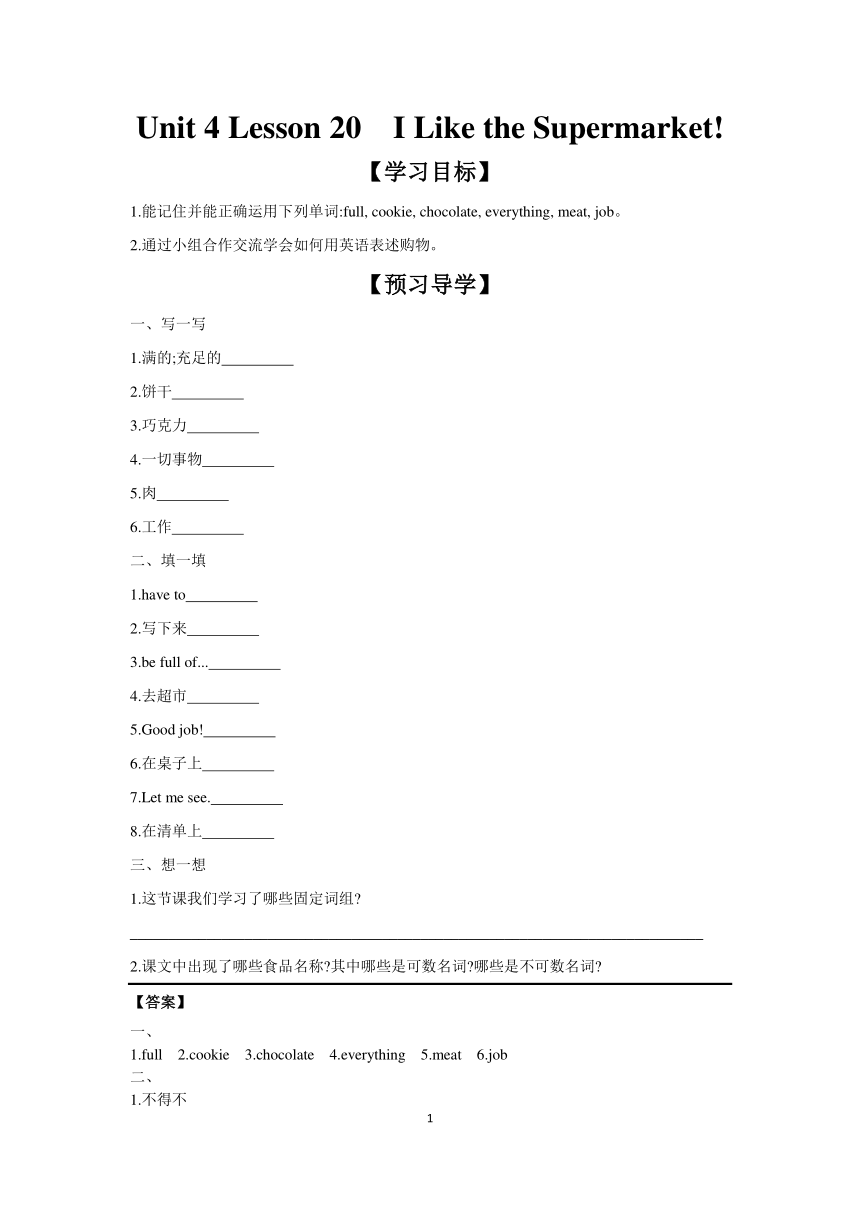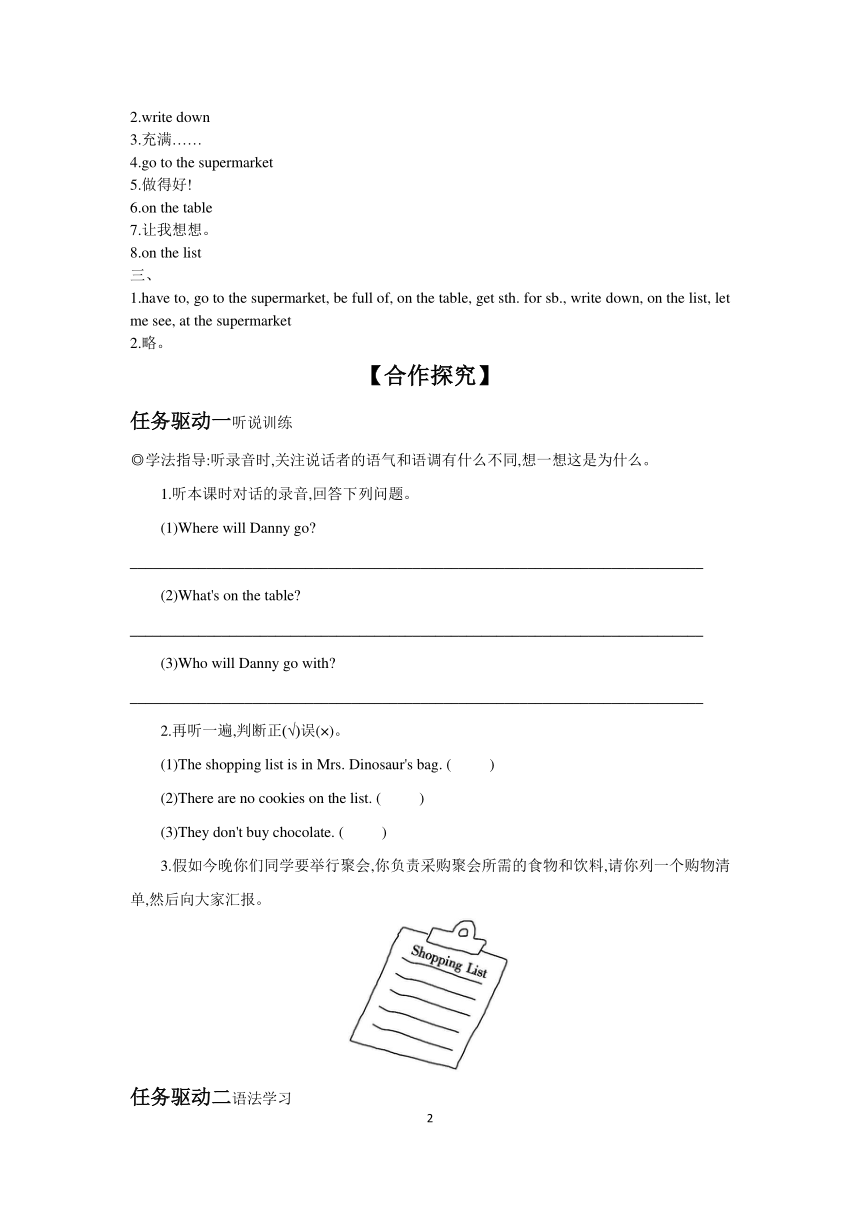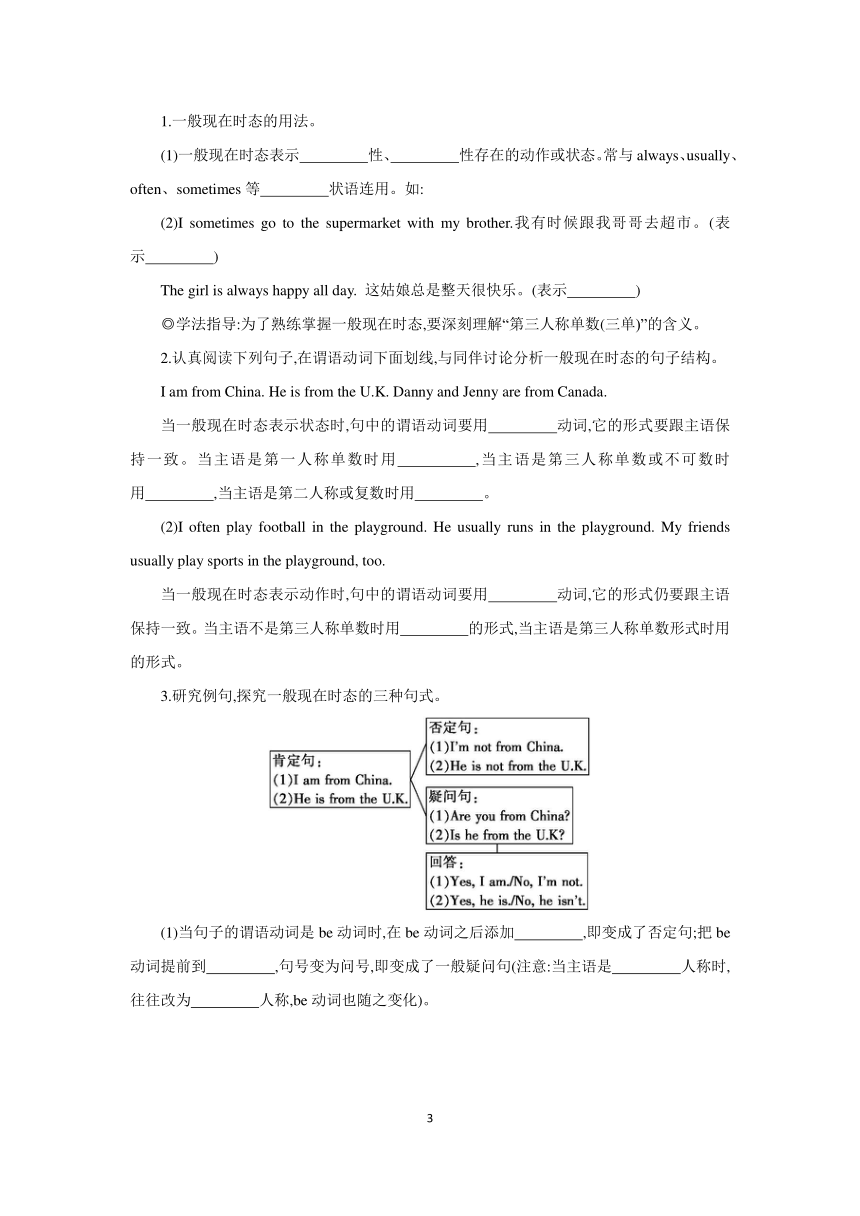冀教版七年级上册Unit 4 Lesson 20 I Like the Supermarket! 学案(含答案)
文档属性
| 名称 | 冀教版七年级上册Unit 4 Lesson 20 I Like the Supermarket! 学案(含答案) |  | |
| 格式 | docx | ||
| 文件大小 | 149.6KB | ||
| 资源类型 | 教案 | ||
| 版本资源 | 冀教版 | ||
| 科目 | 英语 | ||
| 更新时间 | 2024-02-29 11:52:16 | ||
图片预览



文档简介
Unit 4 Lesson 20 I Like the Supermarket!
【学习目标】
1.能记住并能正确运用下列单词:full, cookie, chocolate, everything, meat, job。
2.通过小组合作交流学会如何用英语表述购物。
【预习导学】
一、写一写
1.满的;充足的
2.饼干
3.巧克力
4.一切事物
5.肉
6.工作
二、填一填
1.have to
2.写下来
3.be full of...
4.去超市
5.Good job!
6.在桌子上
7.Let me see.
8.在清单上
三、想一想
1.这节课我们学习了哪些固定词组
___________________________________________________________________________
2.课文中出现了哪些食品名称 其中哪些是可数名词 哪些是不可数名词
【答案】
一、
1.full 2.cookie 3.chocolate 4.everything 5.meat 6.job
二、
1.不得不
2.write down
3.充满……
4.go to the supermarket
5.做得好!
6.on the table
7.让我想想。
8.on the list
三、
1.have to, go to the supermarket, be full of, on the table, get sth. for sb., write down, on the list, let me see, at the supermarket
2.略。
【合作探究】
任务驱动一听说训练
◎学法指导:听录音时,关注说话者的语气和语调有什么不同,想一想这是为什么。
1.听本课时对话的录音,回答下列问题。
(1)Where will Danny go
___________________________________________________________________________
(2)What's on the table
___________________________________________________________________________
(3)Who will Danny go with
___________________________________________________________________________
2.再听一遍,判断正(√)误(×)。
(1)The shopping list is in Mrs. Dinosaur's bag. ( )
(2)There are no cookies on the list. ( )
(3)They don't buy chocolate. ( )
3.假如今晚你们同学要举行聚会,你负责采购聚会所需的食物和饮料,请你列一个购物清单,然后向大家汇报。
任务驱动二语法学习
1.一般现在时态的用法。
(1)一般现在时态表示 性、 性存在的动作或状态。常与always、usually、often、sometimes等 状语连用。如:
(2)I sometimes go to the supermarket with my brother.我有时候跟我哥哥去超市。(表示 )
The girl is always happy all day. 这姑娘总是整天很快乐。(表示 )
◎学法指导:为了熟练掌握一般现在时态,要深刻理解“第三人称单数(三单)”的含义。
2.认真阅读下列句子,在谓语动词下面划线,与同伴讨论分析一般现在时态的句子结构。
I am from China. He is from the U.K. Danny and Jenny are from Canada.
当一般现在时态表示状态时,句中的谓语动词要用 动词,它的形式要跟主语保持一致。当主语是第一人称单数时用 ,当主语是第三人称单数或不可数时用 ,当主语是第二人称或复数时用 。
(2)I often play football in the playground. He usually runs in the playground. My friends usually play sports in the playground, too.
当一般现在时态表示动作时,句中的谓语动词要用 动词,它的形式仍要跟主语保持一致。当主语不是第三人称单数时用 的形式,当主语是第三人称单数形式时用 的形式。
3.研究例句,探究一般现在时态的三种句式。
(1)当句子的谓语动词是be动词时,在be动词之后添加 ,即变成了否定句;把be动词提前到 ,句号变为问号,即变成了一般疑问句(注意:当主语是 人称时,往往改为 人称,be动词也随之变化)。
当句子的谓语动词是实义动词时,首先看句子的 ,当句子主语不是 时(此时谓语动词是原形),在谓语动词前添加 ,即变成了否定句;在句首添加助动词 ,句号变为问号,即变成了一般疑问句;当句子主语是 时(此时谓语动词是三单形式,不是动词原形),在谓语动词前添加 ,再把谓语动词三单形式改为 ,即变成了否定句;在句首添加助动词 ,再把谓语动词三单形式改为 ,句号变为问号,即变成了一般疑问句。
【答案】
任务驱动一
1.(1)He will go to the supermarket.
(2)The shopping list.
(3)His mother.
2.(1)× (2)× (3)×
任务驱动二
1.(1)经常 习惯 时间
(2)动作 状态
2.(1)I am from China.
He is from the U.K.
Danny and Jenny are from Canada.
(2)I often play football in the playground.
He usually runs in the playground.
My friends usually play sports in the playground, too.
实义(行为) 动词原形 第三人称单数
3.(1)not 句首 第一 第二
(2)主语 第三人称单数 don't Do 第三人称单数 doesn't 原形 Does 原形
【知识超市】
[命题点一]名词是表示人或事物名称的词。名词按其所表示的事物的性质分为可数名词和不可数名词。
1.可数名词是可以用数量计算的名词,它有单数形式和复数形式。单数可数名词前要加不定冠词a (an)或表示数量的词等,一般不可以单独使用。例如:a desk, an egg。复数可数名词可以在前面加上具体的数字或some, many这些表示数量的词。例如:three books, some books。对可数名词的数量进行提问,要用how many。例如:
How many apples would you like 你想要多少个苹果
2.不可数名词是不能用数量计算的名词,没有复数形式,前面不能用不定冠词a (an)或数词表示量,但可以用some, much, a little 等表示数量的词来修饰,作主语时常被看成单数。例如:some milk, a little milk。对不可数名词的数量进行提问,要用how much。例如:
How much water do you want 你想要多少水
3.有许多名词在汉语中是可数的,但在英语中却是不可数的。例如:bread, paper, glass, money, work, chalk, meat等。如果要对这些词表示“一”的概念,则需要用一些量词来辅助。常用的量词有a piece of, a bottle of, a cup of, a kilo of 等。
对点自测
单项选择。
( )1.I'd like .
A.two coffee B.two cup of coffee C.two cups of coffee D.two cups of coffees
( )2.I like very much, and my mother usually cooks it for me.
A.fish B.dumplings C.potatoes D.noodles
[命题点二]Danny, I have to go to the supermarket. 丹尼,我不得不去超市。
have to 意为“必须;不得不”,表示客观条件需要某人做某事,to后接动词原形。 have to 有人称、数和时态的变化,其否定结构为don't have to,表示“不必”,相当于 needn't。例如:
I have to study hard. 我不得不努力学习。
【拓展】
情态动词 must 也表示“必须”,但它表示说话人主观上的看法,即主观上的必要性,没有时态和人称变化。例如:
You must work hard at your lessons. 你们必须努力学习你们的功课。
对点自测
单项选择。
( )1.He stay at home because of the rain.
A.have B.has to C.must be D.have to
( )2.—I can't stop playing computer games.
—For your health, my boy, I'm afraid you .
A.can B.may C.must D.have to
[命题点三]It's full of delicious food. 它(超市)满是好吃的食物。
full作形容词, 意为“满的;充足的”,常构成短语be full of,意为“充满……”,be随主语的变化而变化,of后接名词或代词,相当于be filled with。例如:
This box is full of books.= This box is filled with books. 这个箱子里装满了书。
对点自测
按要求完成下列各题。
( )1.The supermarket is people.(单项选择)
full B.filled C.full of D.filled of
2.The classroom is full of students. (同义句转换)
The classroom students.
[命题点四]I can write it down.我能把它写下来。
write down意为“写下来”, 后跟名词时,位置较灵活, 放在down前后均可。若后跟代词, 则必须放在write与down之间。
·用法总结
“动词+副词”短语,后跟名词,副词前后均可;后跟代词,放中间。
对点自测
单项选择。
( )Look at these words on the blackboard. Please .
A.write down it B.write it down C.write down them D.write them down
[命题点五]Good job!做得好!
该句常用于口语中, 用来鼓励别人,赞扬某人某件事做得好。
易错易混
辨析job 和work
job 可数名词,多指具体的某种工作, 强调工作的性质,有时也指临时性的工作 I can't find a good job here. 在这里我找不到一份好工作。
work 不可数名词, 表示“工作;劳动”, 泛指体力或脑力工作,也指抽象意义的工作 We have much work to do. 我们有许多工作要做。
对点自测
单项选择。
( )I have to for ten hours a day. I want to find a new .
job; work B.work; job C.work; work D.job; job
【答案】
命题点一
对点自测
1.C 2.A
命题点二
对点自测
1.B 2.D
命题点三
对点自测
1.C 2.is filled with
命题点四
对点自测
D
命题点五
对点自测
B
2
【学习目标】
1.能记住并能正确运用下列单词:full, cookie, chocolate, everything, meat, job。
2.通过小组合作交流学会如何用英语表述购物。
【预习导学】
一、写一写
1.满的;充足的
2.饼干
3.巧克力
4.一切事物
5.肉
6.工作
二、填一填
1.have to
2.写下来
3.be full of...
4.去超市
5.Good job!
6.在桌子上
7.Let me see.
8.在清单上
三、想一想
1.这节课我们学习了哪些固定词组
___________________________________________________________________________
2.课文中出现了哪些食品名称 其中哪些是可数名词 哪些是不可数名词
【答案】
一、
1.full 2.cookie 3.chocolate 4.everything 5.meat 6.job
二、
1.不得不
2.write down
3.充满……
4.go to the supermarket
5.做得好!
6.on the table
7.让我想想。
8.on the list
三、
1.have to, go to the supermarket, be full of, on the table, get sth. for sb., write down, on the list, let me see, at the supermarket
2.略。
【合作探究】
任务驱动一听说训练
◎学法指导:听录音时,关注说话者的语气和语调有什么不同,想一想这是为什么。
1.听本课时对话的录音,回答下列问题。
(1)Where will Danny go
___________________________________________________________________________
(2)What's on the table
___________________________________________________________________________
(3)Who will Danny go with
___________________________________________________________________________
2.再听一遍,判断正(√)误(×)。
(1)The shopping list is in Mrs. Dinosaur's bag. ( )
(2)There are no cookies on the list. ( )
(3)They don't buy chocolate. ( )
3.假如今晚你们同学要举行聚会,你负责采购聚会所需的食物和饮料,请你列一个购物清单,然后向大家汇报。
任务驱动二语法学习
1.一般现在时态的用法。
(1)一般现在时态表示 性、 性存在的动作或状态。常与always、usually、often、sometimes等 状语连用。如:
(2)I sometimes go to the supermarket with my brother.我有时候跟我哥哥去超市。(表示 )
The girl is always happy all day. 这姑娘总是整天很快乐。(表示 )
◎学法指导:为了熟练掌握一般现在时态,要深刻理解“第三人称单数(三单)”的含义。
2.认真阅读下列句子,在谓语动词下面划线,与同伴讨论分析一般现在时态的句子结构。
I am from China. He is from the U.K. Danny and Jenny are from Canada.
当一般现在时态表示状态时,句中的谓语动词要用 动词,它的形式要跟主语保持一致。当主语是第一人称单数时用 ,当主语是第三人称单数或不可数时用 ,当主语是第二人称或复数时用 。
(2)I often play football in the playground. He usually runs in the playground. My friends usually play sports in the playground, too.
当一般现在时态表示动作时,句中的谓语动词要用 动词,它的形式仍要跟主语保持一致。当主语不是第三人称单数时用 的形式,当主语是第三人称单数形式时用 的形式。
3.研究例句,探究一般现在时态的三种句式。
(1)当句子的谓语动词是be动词时,在be动词之后添加 ,即变成了否定句;把be动词提前到 ,句号变为问号,即变成了一般疑问句(注意:当主语是 人称时,往往改为 人称,be动词也随之变化)。
当句子的谓语动词是实义动词时,首先看句子的 ,当句子主语不是 时(此时谓语动词是原形),在谓语动词前添加 ,即变成了否定句;在句首添加助动词 ,句号变为问号,即变成了一般疑问句;当句子主语是 时(此时谓语动词是三单形式,不是动词原形),在谓语动词前添加 ,再把谓语动词三单形式改为 ,即变成了否定句;在句首添加助动词 ,再把谓语动词三单形式改为 ,句号变为问号,即变成了一般疑问句。
【答案】
任务驱动一
1.(1)He will go to the supermarket.
(2)The shopping list.
(3)His mother.
2.(1)× (2)× (3)×
任务驱动二
1.(1)经常 习惯 时间
(2)动作 状态
2.(1)I am from China.
He is from the U.K.
Danny and Jenny are from Canada.
(2)I often play football in the playground.
He usually runs in the playground.
My friends usually play sports in the playground, too.
实义(行为) 动词原形 第三人称单数
3.(1)not 句首 第一 第二
(2)主语 第三人称单数 don't Do 第三人称单数 doesn't 原形 Does 原形
【知识超市】
[命题点一]名词是表示人或事物名称的词。名词按其所表示的事物的性质分为可数名词和不可数名词。
1.可数名词是可以用数量计算的名词,它有单数形式和复数形式。单数可数名词前要加不定冠词a (an)或表示数量的词等,一般不可以单独使用。例如:a desk, an egg。复数可数名词可以在前面加上具体的数字或some, many这些表示数量的词。例如:three books, some books。对可数名词的数量进行提问,要用how many。例如:
How many apples would you like 你想要多少个苹果
2.不可数名词是不能用数量计算的名词,没有复数形式,前面不能用不定冠词a (an)或数词表示量,但可以用some, much, a little 等表示数量的词来修饰,作主语时常被看成单数。例如:some milk, a little milk。对不可数名词的数量进行提问,要用how much。例如:
How much water do you want 你想要多少水
3.有许多名词在汉语中是可数的,但在英语中却是不可数的。例如:bread, paper, glass, money, work, chalk, meat等。如果要对这些词表示“一”的概念,则需要用一些量词来辅助。常用的量词有a piece of, a bottle of, a cup of, a kilo of 等。
对点自测
单项选择。
( )1.I'd like .
A.two coffee B.two cup of coffee C.two cups of coffee D.two cups of coffees
( )2.I like very much, and my mother usually cooks it for me.
A.fish B.dumplings C.potatoes D.noodles
[命题点二]Danny, I have to go to the supermarket. 丹尼,我不得不去超市。
have to 意为“必须;不得不”,表示客观条件需要某人做某事,to后接动词原形。 have to 有人称、数和时态的变化,其否定结构为don't have to,表示“不必”,相当于 needn't。例如:
I have to study hard. 我不得不努力学习。
【拓展】
情态动词 must 也表示“必须”,但它表示说话人主观上的看法,即主观上的必要性,没有时态和人称变化。例如:
You must work hard at your lessons. 你们必须努力学习你们的功课。
对点自测
单项选择。
( )1.He stay at home because of the rain.
A.have B.has to C.must be D.have to
( )2.—I can't stop playing computer games.
—For your health, my boy, I'm afraid you .
A.can B.may C.must D.have to
[命题点三]It's full of delicious food. 它(超市)满是好吃的食物。
full作形容词, 意为“满的;充足的”,常构成短语be full of,意为“充满……”,be随主语的变化而变化,of后接名词或代词,相当于be filled with。例如:
This box is full of books.= This box is filled with books. 这个箱子里装满了书。
对点自测
按要求完成下列各题。
( )1.The supermarket is people.(单项选择)
full B.filled C.full of D.filled of
2.The classroom is full of students. (同义句转换)
The classroom students.
[命题点四]I can write it down.我能把它写下来。
write down意为“写下来”, 后跟名词时,位置较灵活, 放在down前后均可。若后跟代词, 则必须放在write与down之间。
·用法总结
“动词+副词”短语,后跟名词,副词前后均可;后跟代词,放中间。
对点自测
单项选择。
( )Look at these words on the blackboard. Please .
A.write down it B.write it down C.write down them D.write them down
[命题点五]Good job!做得好!
该句常用于口语中, 用来鼓励别人,赞扬某人某件事做得好。
易错易混
辨析job 和work
job 可数名词,多指具体的某种工作, 强调工作的性质,有时也指临时性的工作 I can't find a good job here. 在这里我找不到一份好工作。
work 不可数名词, 表示“工作;劳动”, 泛指体力或脑力工作,也指抽象意义的工作 We have much work to do. 我们有许多工作要做。
对点自测
单项选择。
( )I have to for ten hours a day. I want to find a new .
job; work B.work; job C.work; work D.job; job
【答案】
命题点一
对点自测
1.C 2.A
命题点二
对点自测
1.B 2.D
命题点三
对点自测
1.C 2.is filled with
命题点四
对点自测
D
命题点五
对点自测
B
2
同课章节目录
- Unit 1 School and friends
- Lesson 1 Hello!
- Lesson 2 Teacher and Students
- Lesson 3 Welcome to Our School
- Lesson 4 What Is It?
- Lesson 5 May I Have a Book?
- Lesson 6 Things for School
- Unit 2 Colours and Clothes
- Lesson 7 Jenny's New Skirt
- Lesson 8 Danny's Favourit Colou
- Lesson 9 Whose Coat Is This?
- Lesson 10 Clothes for a Cold Day
- Lesson 11 Clothes around the World
- Lesson 12 Let's Go Shopping!
- Unit 3 Body Parts and Feelings
- Lesson 13 Body Parts
- Lesson 14 Colours and Feelings
- Lesson 15 Tall or Short
- Lesson 16 Happy or Sad
- Lesson 17 Seeing a Docto
- Lesson 18 We All Look Different!
- Unit 4 Food and Restaurants
- Lesson 19 Time for Breakfast!
- Lesson 20 I Like the Supermarket!
- Lesson 21 At the Market
- Lesson 22 In the Restaurant
- Lesson 23 The Corner Store
- Lesson 24 Eat Good Food!
- Unit 5 Family and Home
- Lesson 25 Jenny's Family
- Lesson 26 Li Ming's Family
- Lesson 27 Danny at Home
- Lesson 28 A Family Picnic
- Lesson 29 A Birthday Card
- Lesson 30 Grandma's Birthday Party
- Unit 6 Let's Go!
- Lesson 31 Let's Go to the Bookstore!
- Lesson 32 At the Supermarket
- Lesson 33 Let's Go to the Zoo!
- Lesson 34 On the Farm
- Lesson 35 Let's Go to the Museum!
- Lesson 36 Let's Go to the Movie Theatre!
- Unit 7 Days and Months
- Lesson 37 Seasons and Weathe
- Lesson 38 Nick's Busy Month
- Lesson 39 A Class Calenda
- Lesson 40 When Is Your Birthday?
- Lesson 41 Holidays
- Lesson 42 Happy Holidays!
- Unit 8 Countries around the world
- Lesson 43 Directions
- Lesson 44 Jack's Goodbye Party
- Lesson 45 China
- Lesson 46 Canada and the U.S.
- Lesson 47 The U.K. and Australia
- Lesson 48 English-Speaking Countries
